Heat Transfer Analysis of a Co-Current Heat Exchanger with Two Rectangular Mini-Channels
Abstract
1. Introduction
- Testing a new construction of a mini heat exchanger, which required essential changes compared to previous constructions;
- The proposition of a mathematical model to describe heat transfer in a mini heat exchanger with two channels, fixed on the mini-channel with hot fluid flow.
2. Experiment
2.1. Experimental Stand and Test Section
2.2. Experimental Procedure, Parameters and Errors
3. The Methods of Heat Transfer Coefficient Determination
3.1. General Assumptions
- steady state in the test section and temperature independence of the physical parameters of the test section’s elements,
- negligible heat losses to the environment through the external surfaces of the test section; the system is insulated,
- convective heat transfer in the mini-channels,
- the parallel flow of the fluids from both sides of the copper plate,
3.2. Two-Dimensional Approach
- -
- the parabolic velocity is parallel to the heated plate and is satisfying the following condition:
- -
- the temperature of the FC-72 fluid (flowing in the hot mini-channel) at the contact area with the heated plate at the mini-channel inlet and outlet is known, i.e.,:
3.3. One-Dimensional Approach
| Author | Equation | Remarks |
|---|---|---|
| Cooper [18] |
| |
| Mikielewicz [20] | —heat transfer coefficient calculated from Equation (19) —heat transfer coefficient determined from Dittus–Boelter Equation [19]: |
|
| Dutkowski [17] |
|
4. Results and Discussion
- -
- -
5. Conclusions
- In the hot mini-channel, heat transfer was transferred by single-phase convection and subcooled boiling occurs near the channel outlet; the heat transfer coefficients determined for both contact surfaces, that is, the Haynes-230 plate–the fluid FC-72 (α1) and the copper plate–FC-72 (α2) increased with increasing heat flux regardless of the calculation method chosen;
- In the cold mini-channel, the temperature differences between plates and distilled water were low, as single-phase convection occurs in the entire mini-channel;
- The resulting heat transfer coefficient at the heated plate–fluid FC-72 interface α1 reached values on the order of several hundred to a maximum of more than two thousand W/(m2K);
- For the same experimental data, the α2 values are lower than those of α1;
- For both mathematical approaches, the calculation results are similar, with higher heat transfer coefficients from the 2D approach compared with the corresponding coefficients from the 1D approach;
- For the heat transfer coefficients on the heated plate–FC-72 contact surface (α1), the maximum relative differences between the results obtained from the two approaches (1D and 2D) decrease with increasing heat flux and do not exceed 67%;
- For the heat transfer coefficient on the FC-72–cooper plate contact surface (α2), the maximum relative differences between the results (obtained from the 2D approach and the selected correlations) decrease with increasing heat flux supplied to the heated plate; good agreement with the experimental results showed those determined from Dutkowski correlation: the smallest relative differences equal to 12.69% were obtained for q = 25.94 kW/m2.
- The values of the mean relative errors are smaller for the 1D approach compared to the 2D method and, for both calculation methods, decrease with increasing heat flux supplied to the heated plate reaching the highest value of 14.7% for q = 12.26 kW/m2. For the 1D approach, the mean relative errors are evenly distributed along the entire length of the mini-channel, while for the 2D approach, they increase with the distance from the inlet to the mini-channel.
Author Contributions
Funding
Institutional Review Board Statement
Informed Consent Statement
Data Availability Statement
Acknowledgments
Conflicts of Interest
Nomenclature
| A | surface area, m2 |
| cp | specific heat, J/(kgK) |
| d | diameter, m |
| f | Fanning friction factor |
| G | mass flux, kg/(m2s) |
| hlv | latent heat of vaporization, J/kg |
| I | current, A |
| K | channel aspect ratio |
| k | overal heat transfer coefficient, W/(m2 K) |
| L | length of the mini-channel, m |
| M | molecular weight, kg/mol |
| p | pressure, Pa |
| Q | heat flux, W |
| Qm | mass flow rate, kg/s |
| q | heat flux density, W/m2 |
| Rp | roughness parameter, μm |
| T | temperature, K |
| log mean temperature difference, K | |
| ΔU | voltage drop, V |
| w | velocity, m/s |
| x | coordinate in the direction of flow, m |
| y | coordinate in the direction perpendicular to the flow and width of the partitions, m |
| Laplacian in Cartesian coordinates | |
| Greek Letters | |
| α | heat transfer coefficient, W/(m2K) |
| Δ | difference, |
| δ | thickness, depth, m |
| λ | thermal conductivity, W/(mK) |
| µ | dynamic viscosity, Pa∙s |
| ρ | density, kg/m3 |
| σ | surface tension, N/m |
| Dimensionless Numbers | |
| boiling number | |
| confinement number | |
| Graetz numer | |
| Jakobe number | |
| Kutateladze number | |
| Prandtl number | |
| Reynolds number | |
| Subscripts | |
| ave | average |
| Cu | copper plate |
| DB | refers to Dittus–Boelter correlation |
| FC | FC-72 fluid |
| H | heated plate |
| h | hydraulic |
| in | at the inlet |
| IR | thermal imaging camera |
| l | liquid |
| lin | linear function |
| out | at the outlet |
| PB | pool boiling |
| r | reduced (pressure) |
| ref | reference |
| sat | saturation |
| TP | two phase flow boiling |
| v | vapour |
| w | water |
| 1 | contact surface: Haynes-230 plate—FC-72 fluid |
| 2 | contact surface: FC-72 fluid—copper plate |
| 1D | one-dimensional approach |
| 2D | two-dimensional approach |
References
- Bari, F.; Morshed, A.K.M.M. Ultra compact Heat Exchanger with geometry induced wall jet. Procedia Eng. 2015, 105, 258–263. [Google Scholar] [CrossRef][Green Version]
- Anusha, G.; Kishore, P.S. Heat Transfer Analysis of Gasketed Plate Heat Exchanger. Int. J. Technol. Res. Eng. 2016, 5, 943–947. [Google Scholar] [CrossRef]
- Wajs, J.; Mikielewicz, D. Influence of metallic porous microlayer on pressure drop and heat transfer of stainless steel plate heat exchanger. Appl. Therm. Eng. 2016, 93, 1337–1346. [Google Scholar] [CrossRef]
- Rahul; Kumar, N.; Sehrawat, V.; Gupta, T.; Manju, R.; Iqbal Ahmad, M. Design Analysis of Gasketed Plate Heat Exchanger. Int. J. Technol. Res. Eng. 2017, 4, 1682–1685. [Google Scholar]
- Javadi, F.S.; Sadeghipour, S.; Saidur, R.; BoroumandJazi, G.; Rahmati, B.; Elias, M.M.; Sohel, M.R. The effects of nanofluid on thermophysical properties and heat transfer characteristics of a plate heat exchanger. Int. Commun. Heat Mass Transfer 2013, 44, 58–63. [Google Scholar] [CrossRef]
- Cheng, L.; Xia, G. Fundamental issues, mechanisms and models of flow boiling heat transfer in microscale channels. Int. J. Heat Mass Transfer 2017, 108, 97–127. [Google Scholar] [CrossRef]
- Rybiński, W.; Mikielewicz, J. Analytical 1D models of the wall thermal resistance of rectangular minichannels applied in heat exchangers. Arch. Thermodyn. 2016, 37, 63–78. [Google Scholar] [CrossRef][Green Version]
- Huang, Q.; Jia, L.; Dang, C.; Yang, L. Experimental study on the effect of step-changing heating on water flow boing in a horizontal long mini-channel. Heat Mass Transfer 2020, 56, 973–988. [Google Scholar] [CrossRef]
- Duan, J.; Zhao, J.; Li, X.; Panchal, S.; Yuan, J.; Fraser, R.; Fowler, M. Modeling and Analysis of Heat Dissipation for Liquid Cooling Lithium-Ion Batteries. Energies 2021, 14, 4187. [Google Scholar] [CrossRef]
- Hożejowska, S.; Piasecka, M. Numerical Solution of Axisymmetric Inverse Heat Conduction Problem by the Trefftz Method. Energies 2020, 13, 705. [Google Scholar] [CrossRef]
- Yin, C.P.; Yan, Y.Y.; Lin, T.F.; Yang, B.C. Subcooled flow boiling heat transfer of R-134a and bubble characteristics in a horizontal annular duct. Int. J. Heat Mass Transfer 2000, 43, 1885–1896. [Google Scholar] [CrossRef]
- Piasecka, M.; Musiał, T.; Piasecki, A. Cooling liquid flow boiling heat transfer in an annular minigap with an enhanced wall. EPJ Web Conf. 2019, 213, 02066. [Google Scholar] [CrossRef]
- Tran, T.N.; Wambsganss, M.W.; France, D.M. Small circular- and rectangular-channel boiling with two refrigerants. Int. J. Multiph. Flow 1996, 22, 485–498. [Google Scholar] [CrossRef]
- Hasan, T.T.; Saihood, R.G. Numerical Investigation of Developing Laminar Fluid Flow Through Rectangular Annulus Duct. J. Mech. Contin. Math. Sci. 2020, 15, 55–66. [Google Scholar] [CrossRef]
- Piasecka, M.; Maciejewska, B.; Łabędzki, P. Heat Transfer Coefficient Determination during FC-72 Flow in a Minichannel Heat Sink Using the Trefftz Functions and ADINA Software. Energies 2020, 13, 6647. [Google Scholar] [CrossRef]
- Piasecka, M.; Piasecki, A.; Dadas, N. Experimental Study and CFD Modeling of Fluid Flow and Heat Transfer Characteristics in a Mini-channel Heat Sink Using Simcenter STAR-CCM+ Software. Energies 2022, 15, 536. [Google Scholar] [CrossRef]
- Strąk, K.; Piasecka, M. The applicability of heat transfer correlations to flows in minichannels and new correlation for subcooled flow boiling. Int. J. Heat Mass Transfer 2020, 158, 119933. [Google Scholar] [CrossRef]
- Cooper, M.G. Heat Flow Rates in Saturated Nucleate Pool Boiling-A Wide-Ranging Examination Using Reduced Properties. Adv. Heat Transfer 1984, 16, 157–239. [Google Scholar] [CrossRef]
- Dittus, F.W.; Boelter, L.M.K. Heat transfer in automobile radiators of the tubular type. Int. Commun. Heat Mass Transfer 1985, 12, 3–22. [Google Scholar] [CrossRef]
- Mikielewicz, J. Semi-empirical method of determining the heat-transfer coefficient for subcooled, saturated boiling in a channel. Int. J. Heat Mass Transfer 1974, 17, 1129–1134. [Google Scholar] [CrossRef]
- Piasecka, M.; Strąk, K. Characteristics of Refrigerant Boiling Heat Transfer in Rectangular Mini-Channels during Various Flow Orientations. Energies 2021, 14, 4891. [Google Scholar] [CrossRef]
- Piasecka, M.; Strąk, K.; Maciejewska, B. Heat transfer characteristics during flow along horizontal and vertical minichannels. Int. J. Multiph. Flow 2021, 137, 103559. [Google Scholar] [CrossRef]
- Piasecka, M.; Hożejowska, S.; Maciejewska, B.; Pawińska, A. Time-Dependent Heat Transfer Calculations with Trefftz and Picard Methods for Flow Boiling in a Mini-Channel Heat Sink. Energies 2021, 14, 1832. [Google Scholar] [CrossRef]
- Trefftz, E. Ein Gegenstück zum Ritzschen Verfahren. In Proceedings of the International Kongress für Technische Mechanik, Zürich, Switzerland, 12–17 September 1926; pp. 131–137. [Google Scholar]
- Hożejowski, L.; Hożejowska, S. Trefftz method in an inverse problem of two-phase flow boiling in a minichannel. Eng. Anal. Bound. Elem. 2019, 98, 27–34. [Google Scholar] [CrossRef]
- Hożejowska, S.; Maciejewska, B.; Poniewski, M.E. Numerical Analysis of Boiling Two-Phase Flow in Mini- and Microchannels. In Encyclopedia of Two-Phase Heat Transfer and Flow I. Fundamentals and Method. Vol. 4 Special Topics in Pool an Flow Boiling; Thome, J.R., Ed.; World Scientific Publishing Co., Ltd.: New York, NY, USA; London, UK; Singapore, 2016; pp. 131–160. [Google Scholar]
- Strąk, D.; Piasecka, M.; Hożejowska, S.; Pawińska, A. The concept of a prototype compact heat exchanger with minichannels. In Proceedings of the International Conference Experimental Fluid Mechanics 2019, Franzensbad, Czech Republic, 19–22 November 2019; pp. 475–480. [Google Scholar]
- Michalski, D.; Strąk, K.; Piasecka, M. Estimating uncertainty of temperature measurements for studies of flow boiling heat transfer in minichannels. EPJ Web Conf. 2019, 213, 02059. [Google Scholar] [CrossRef]
- Hadamard, J.; Morse, P.M. Lectures on Cauchy’s Problem in Linear Partial Differential Equations. Phys. Today 1953, 6, 18. [Google Scholar] [CrossRef]
- Grabowski, M.; Poniewski, M.E.; Hożejowska, S.; Pawińska, A. Numerical Simulation of the Temperature Fields in a Single-Phase Flow in an Asymmetrically Heated Minichannel. J. Eng. Phys. Thermophys. 2020, 93, 355–363. [Google Scholar] [CrossRef]
- Lienhard, J.H., IV; Lienhard, J.H., V. A Heat Transfer Textbook, 5th ed.; Dover Publications: Mineola, NY, USA, 2019; ISBN 9780486837352. [Google Scholar]
- Rybiński, W.; Mikielewicz, J. Analytical solutions of heat transfer for laminar flow in rectangular channels. Arch. Thermodyn. 2014, 35, 29–42. [Google Scholar] [CrossRef]
- Shah, R.K.; London, A.L. Laminar Flow Forced Convection in Ducts: A Source Book for Compact Heat Exchanger Analytical Data. In Laminar Flow Forced Convection in Ducts; Academic Press, Inc. (London) Ltd.: London, UK, 1978. [Google Scholar]
- Grabowski, M.; Hożejowska, S.; Pawińska, A.; Poniewski, M.E.; Wernik, J. Heat Transfer Coefficient Identification in Mini-Channel Flow Boiling with the Hybrid Picard-Trefftz Method. Energies 2018, 11, 2057. [Google Scholar] [CrossRef]
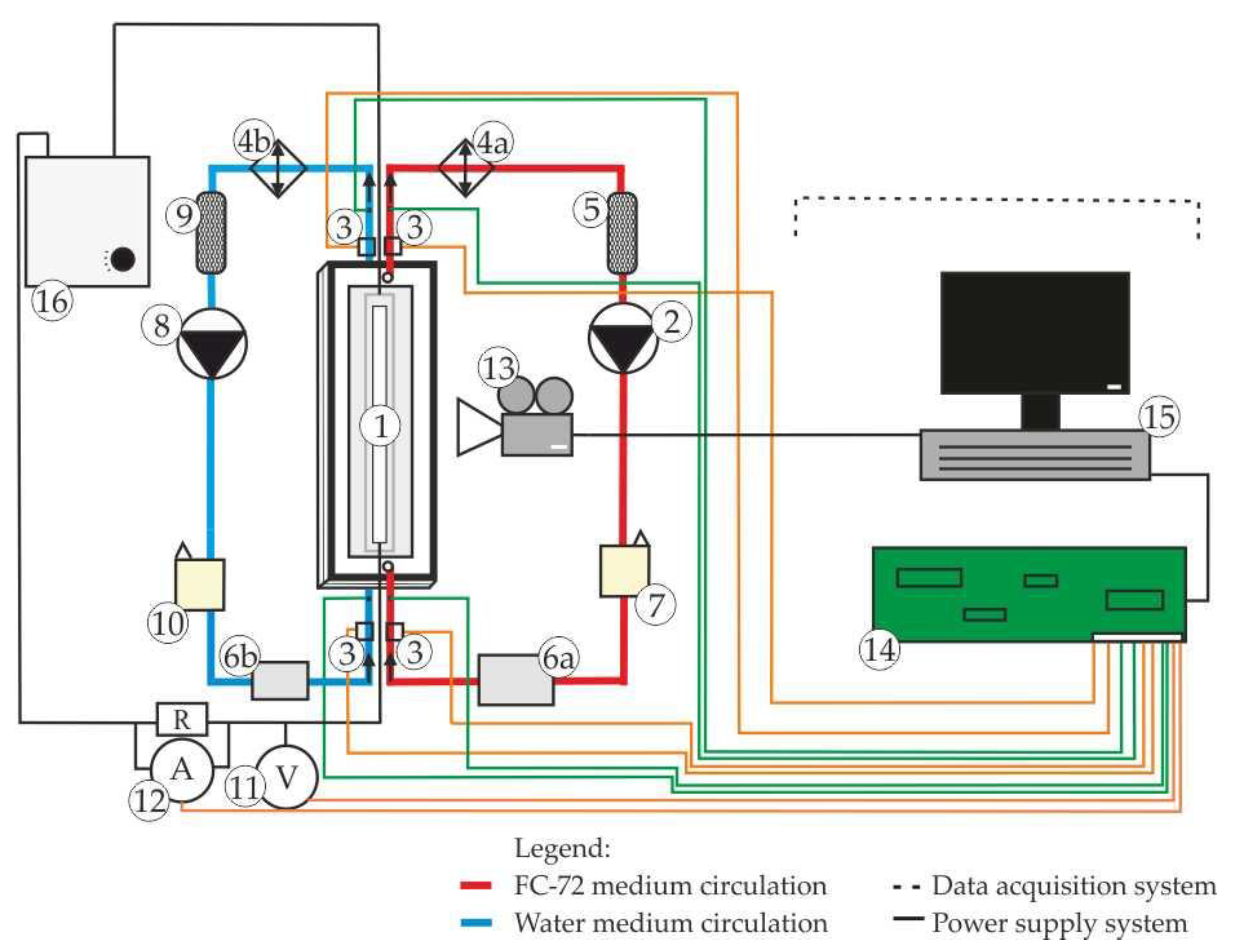
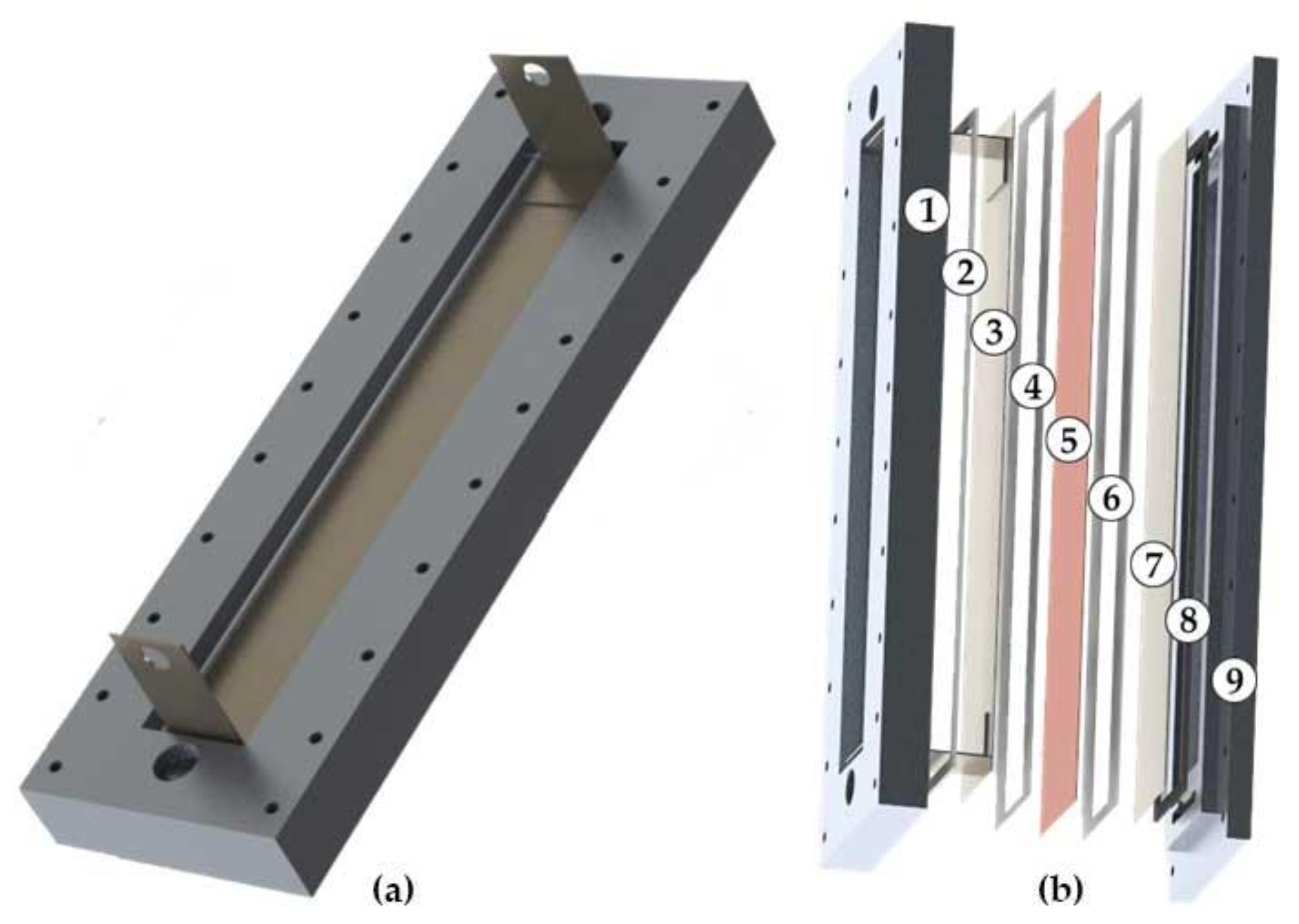
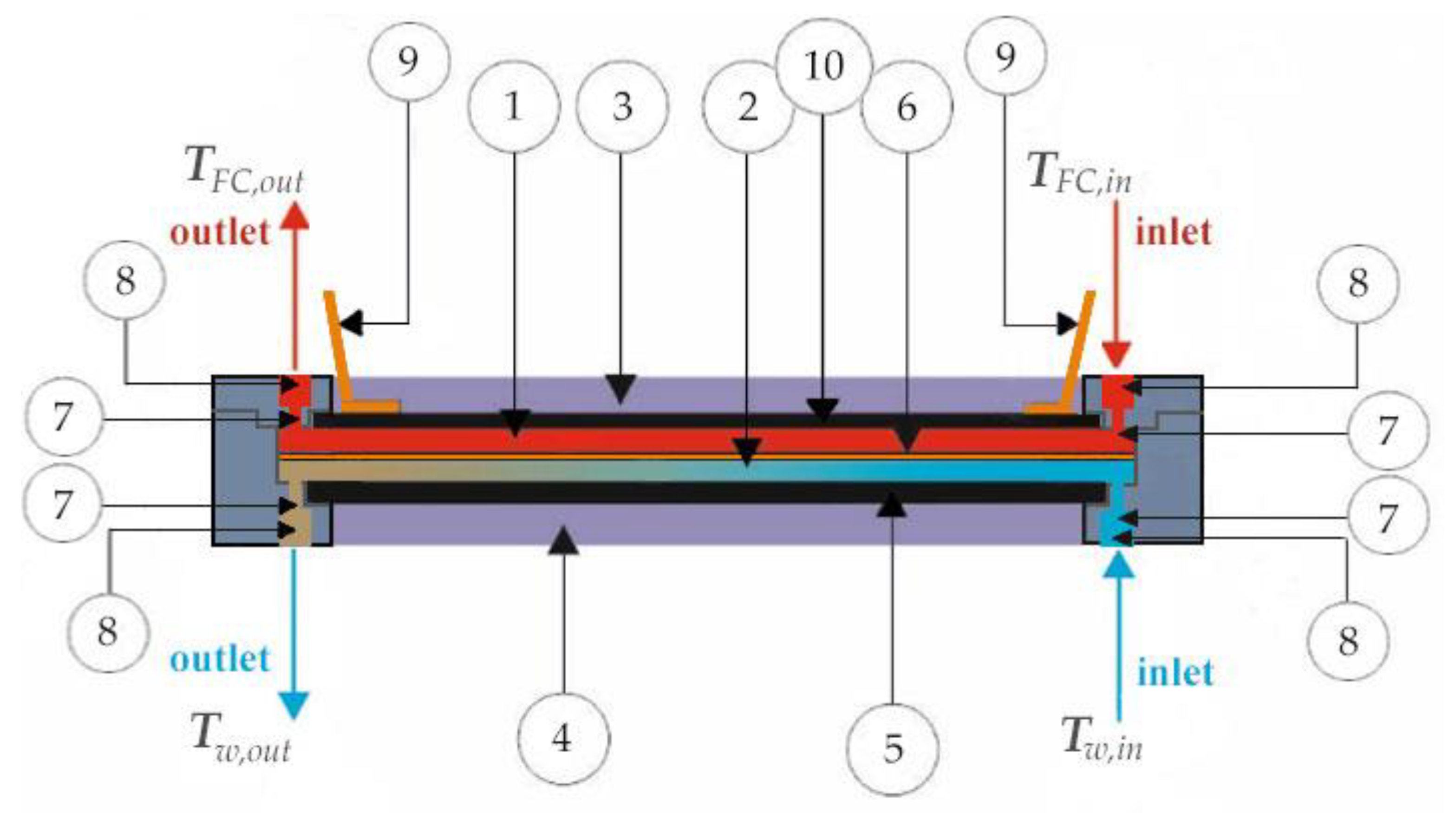
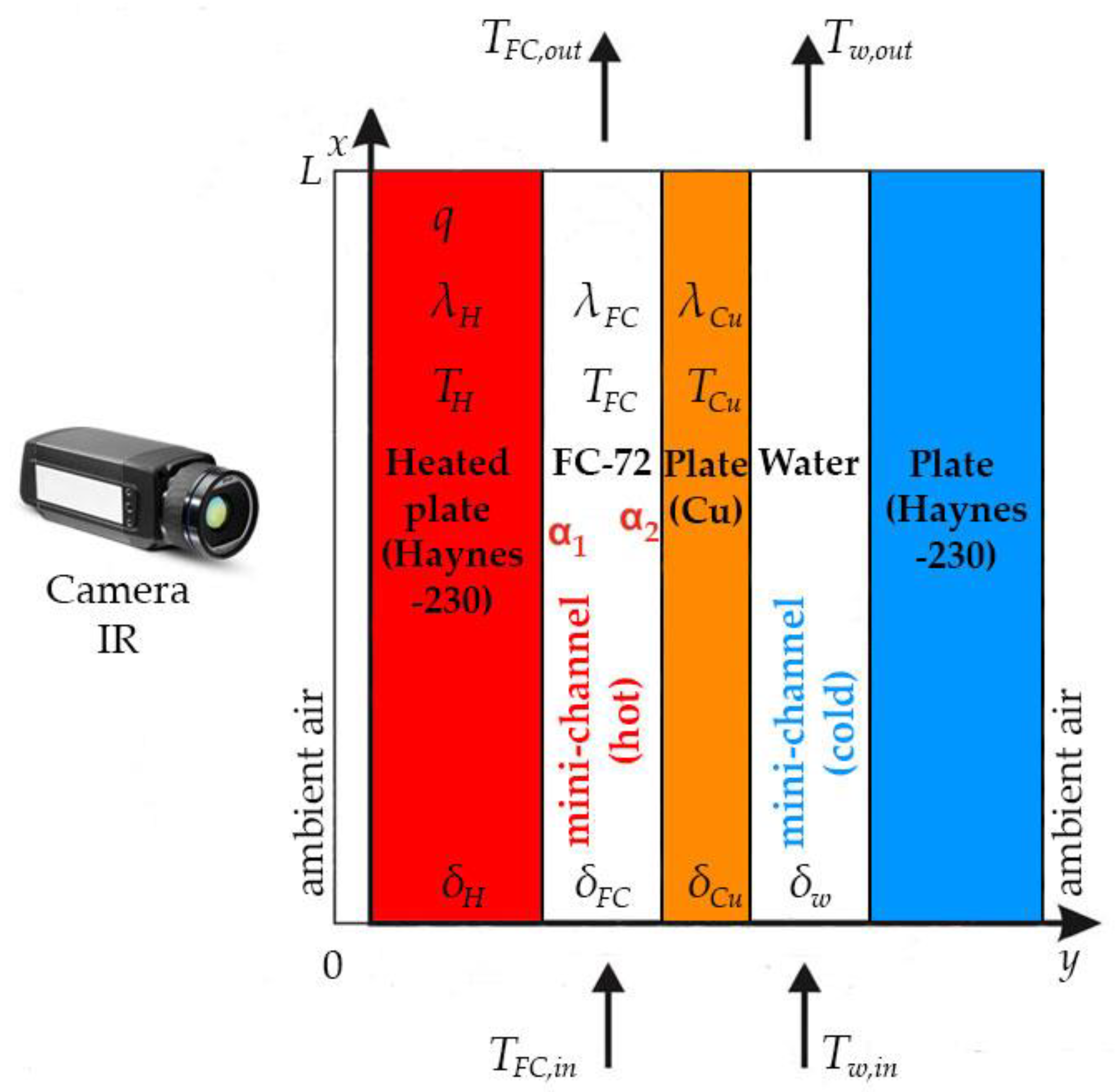
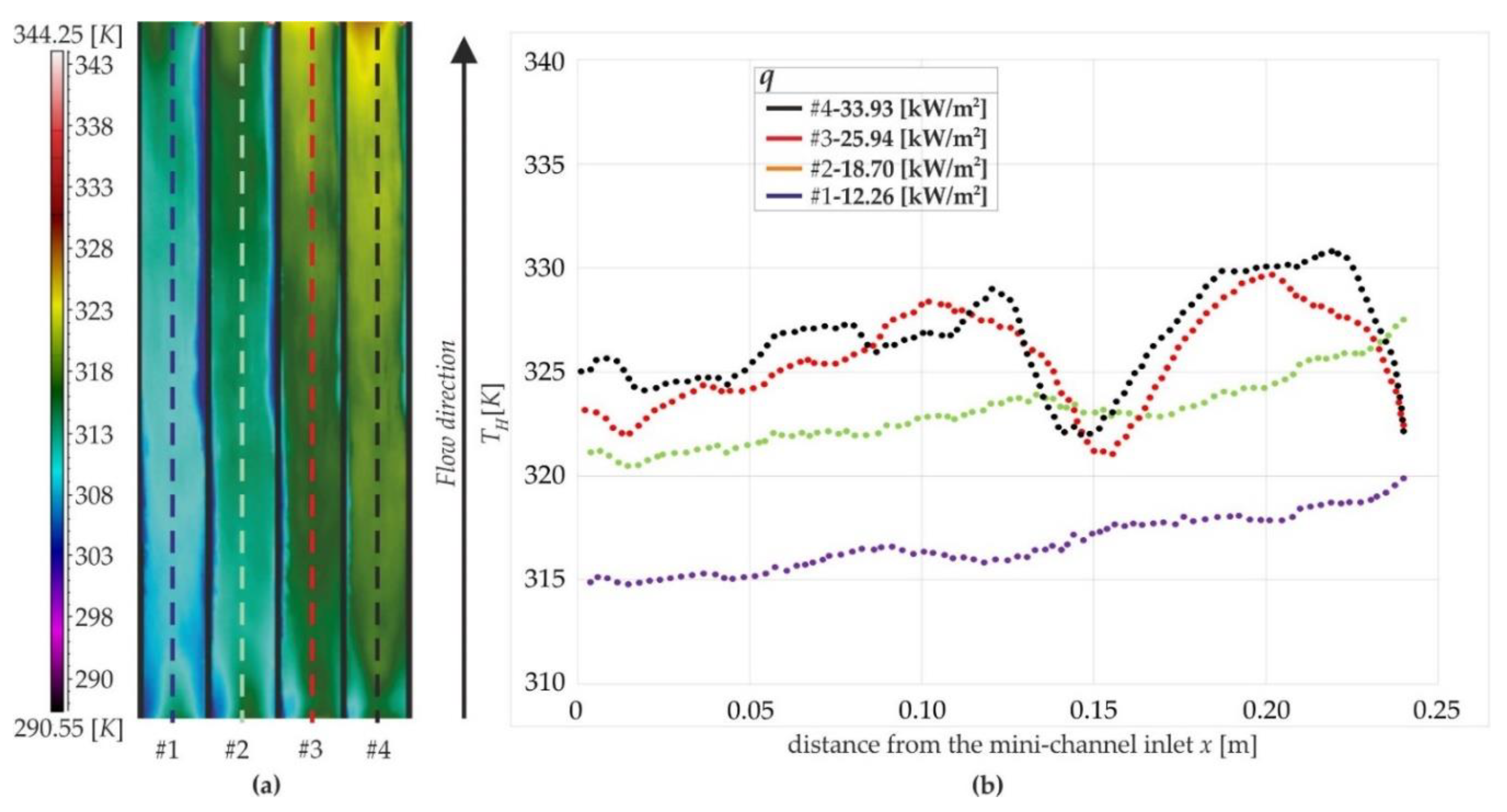
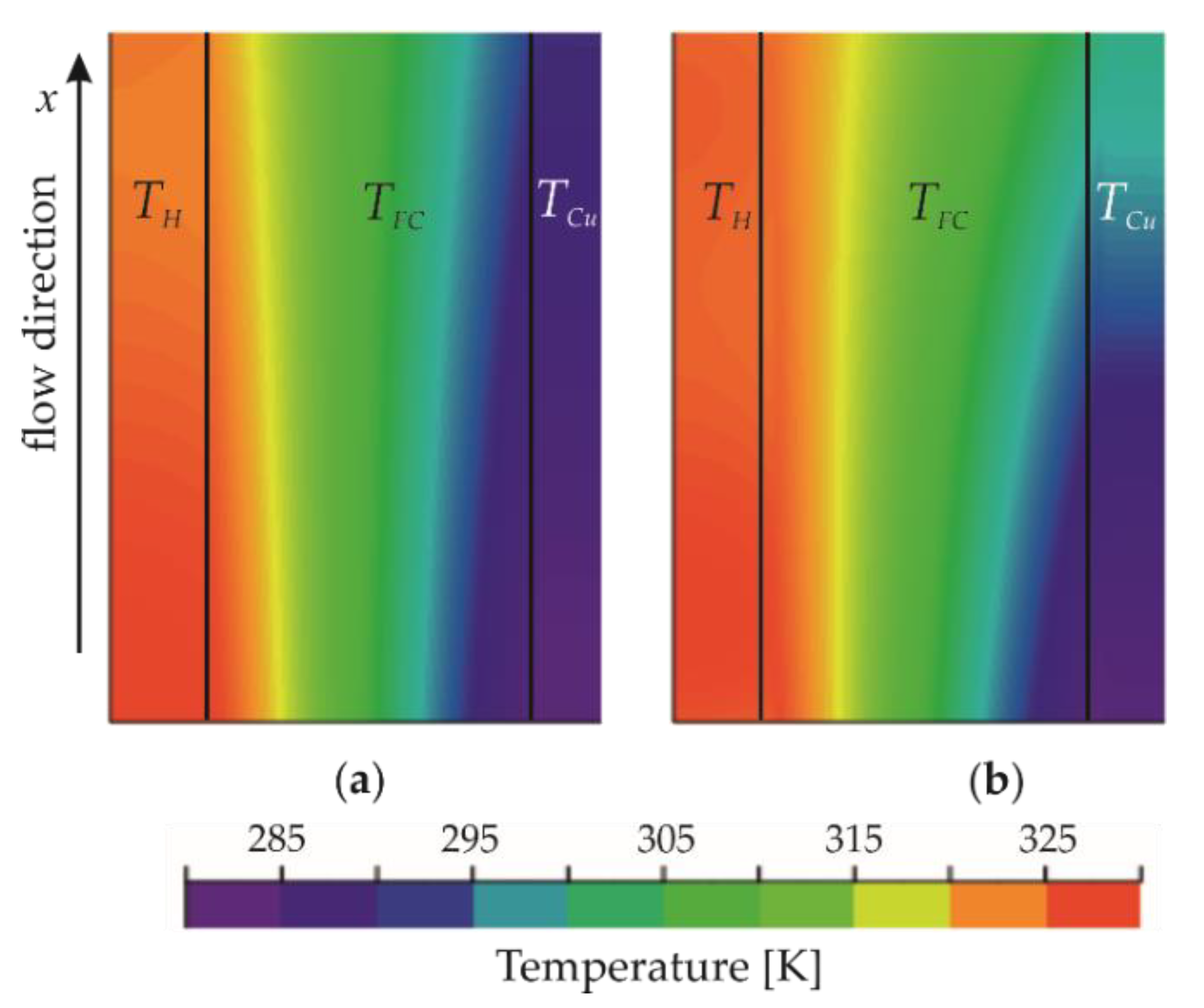

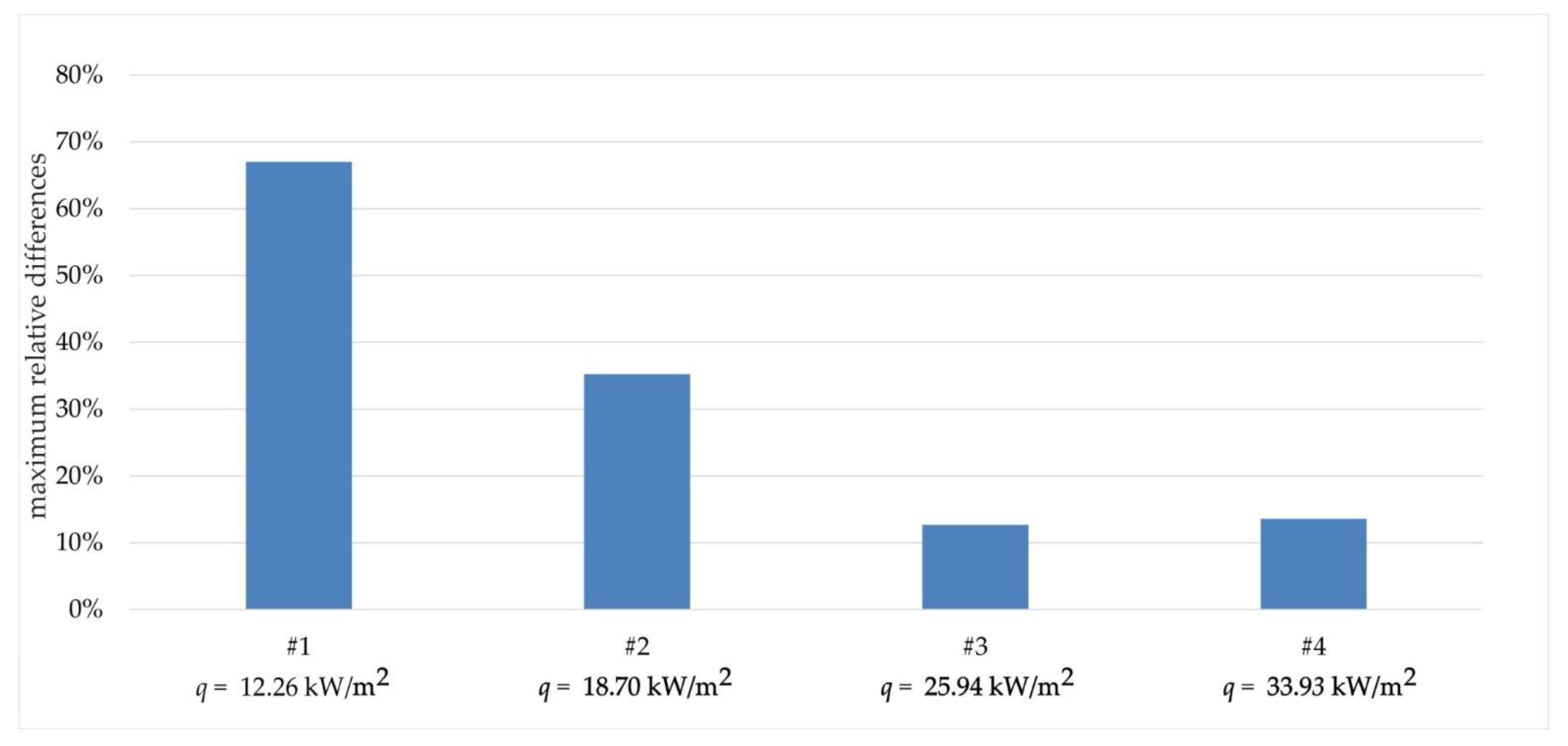
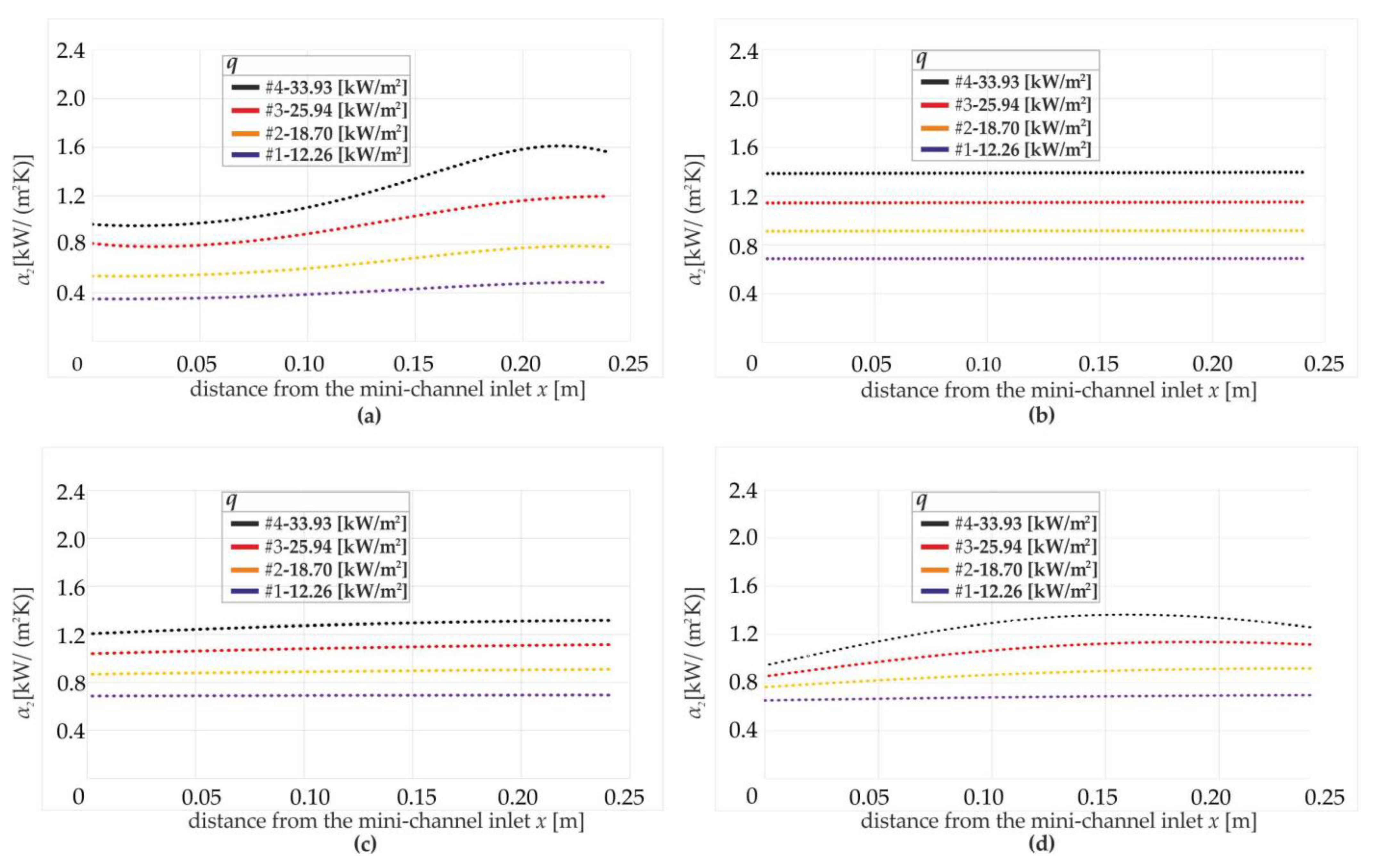
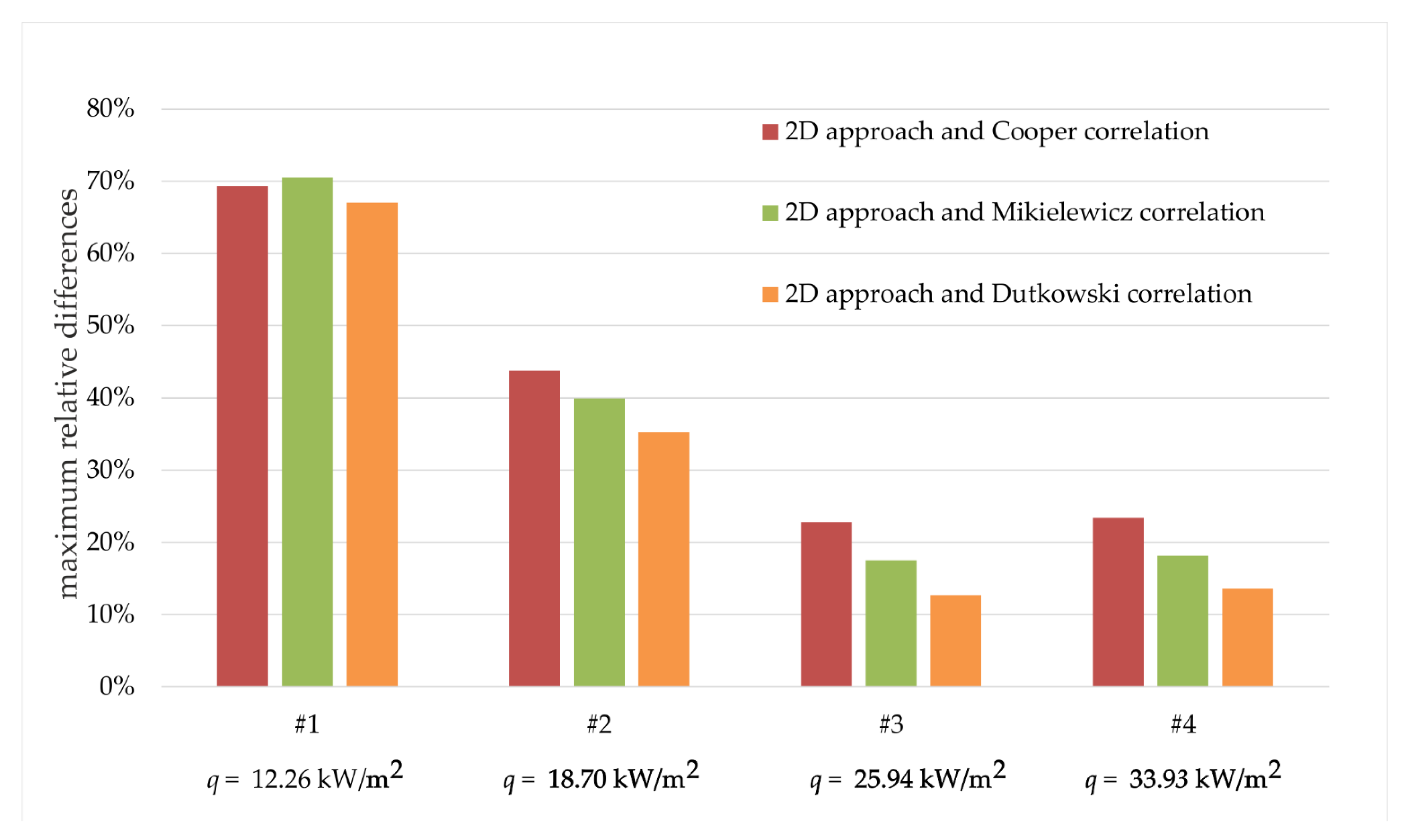

| Parameter | Device | Manufacturer/ Type/Model | Basic Technical Data | Measurement Range | Maximum Uncertainty of Measurement |
|---|---|---|---|---|---|
| Temperature of the heated plate TH,IR | Thermal imaging camera | FLIR A655SC | Spectrum range: 7.5 ÷ 14 µm Resolution: 640 × 480 pixels | −40–150 °C 100–650 °C | ±2 °C or ±2% of reading * |
| Temperature of FC-72 TFC,in, TFC,out Temperature of water Tw,in, Tw,out | Thermocouple | K-type Thermocouple, Czaki Thermo-Product, type K 221 b | NiCr, NiAl sensor with a galvanically isolated weld | −40–375 °C | Calibration tolerance 1.5 °C [28] |
| Gauge pressure at the hot mini-channel | Pressure meter | Endress + Hauser, Cerabar S PMP71 | Working temperature −25 ÷ +55 °C | 0–10 bar | ±0.05% of reading [23] |
| Gauge pressure at the cold mini-channel | Pressure meter | Wika, A-10 | Output signal: 4 ÷ 20 mA DC supply: 8 ÷ 30 V | 0–10 bar | 0.5% of full scale * |
| Atmospheric pressure | Pressure meter | Wika, A-10 | Output signal: 4 ÷ 20 mA DC supply: 8 ÷ 30 V | 0–2.5 bar | 0.5% of full scale * |
| Mass flow rate of FC-72 (the hot mini-channel) | Coriolis mass flow meter | Endress + Hauser, Proline Promass A 100 | Nominal diameter: 4 mm Medium temperature: up to +205 °C | 0–0.125 kg/s | ±0.1% of reading [23] |
| Mass flow rate of distilled water (the cold mini-channel) | Magnetic mass flow meter | SM6004 | Nominal diameter: 15 mm Medium temperature: up to +205 °C | 6–1500 kg/s | ±0.2% of reading * |
| Current, Voltage | Ammeter Voltmeter | Datafort hMeasuring Module 8b32-01 Data Acquisition Station MCC SC-1608G Series | 1500 Vrms Isolation, Input Protection: Continuous 40VAC, ANSI/IEEE Transient C37.90.1, Power Supply Voltage: +5VDC ± 5%, Power Supply Current: 30 mA, Power Supply Sensitivity: ±75 ppm/% | 4 mA–20 mA 0 V–5 V or 0–10 V | ±0.05% Accuracy * ±0.02% hLinearity * |
| Physical Properties/ Experimental Data | Fluorinert FC-72 | Distilled Water | ||||||
|---|---|---|---|---|---|---|---|---|
| Number of heat flux setting | #1 | #2 | #3 | #4 | #1 | #2 | #3 | #4 |
| Heat flux, q [kW/m2] | 12.26 | 18.70 | 25.94 | 33.93 | 12.26 | 18.70 | 25.94 | 33.93 |
| Main physical properties | ||||||||
| Thermal conductivity, λl [W/(mK)] | 0.062 | 0.062 | 0.062 | 0.062 | 0.59 | 0.59 | 0.59 | 0.59 |
| Density, ρl [kg/m3] | 1721.2 | 1723.7 | 1723.2 | 1720.8 | 999.2 | 999.2 | 999.2 | 999.2 |
| Main experimental data | ||||||||
| Mass flow rate, Qm [kg/s] | 0.0091 | 0.0091 | 0.0091 | 0.0091 | 0.00515 | 0.00559 | 0.00489 | 0.00556 |
| Temperature, Tl,in [K] | 296.25 | 293.65 | 291.95 | 290.85 | 286.55 | 286.45 | 286.45 | 286.45 |
| Temperature, Tl,out [K] | 299.45 | 300.55 | 302.55 | 305.05 | 289.25 | 288.95 | 289.05 | 289.25 |
| Gauge pressure, pin [Pa] | 9000 | 9000 | 11,000 | 14,000 | 48,020 | 33,440 | 56,890 | 66,430 |
| Gauge pressure, pout [Pa] | 9000 | 10,000 | 12,000 | 16,000 | 25,980 | 18,820 | 26,510 | 57,150 |
| Number of Heat Flux Setting | #1 | #2 | #3 | #4 |
|---|---|---|---|---|
| ReFC | 1113.81 | 1098.32 | 1097.36 | 1106.20 |
| Rew | 536.13 | 580 | 508.24 | 577.92 |
| PrFC | 11.55 | 11.54 | 11.51 | 11.25 |
| Prw | 8.06 | 8.11 | 8.10 | 8.07 |
| GzFC | 151.36 | 157.50 | 157.18 | 145.99 |
| Gzw | 50.86 | 55.36 | 48.43 | 54.91 |
| k | 790.02 | 1203.18 | 1554.23 | 2018.38 |
| 0.020 | 0.021 | 0.021 | 0.020 | |
| 0.042 | 0.039 | 0.044 | 0.039 |
| The Mean Relative Error [%] | ||||
|---|---|---|---|---|
| Number of Heat Flux Setting | ||||
| #1 | 1.41 | 12.93 | 14.6 | 14.7 |
| #2 | 1.11 | 9.46 | 10.7 | 10.8 |
| #3 | 0.93 | 8.82 | 10.4 | 10.5 |
| #4 | 0.08 | 8.93 | 9.9 | 10.1 |
Publisher’s Note: MDPI stays neutral with regard to jurisdictional claims in published maps and institutional affiliations. |
© 2022 by the authors. Licensee MDPI, Basel, Switzerland. This article is an open access article distributed under the terms and conditions of the Creative Commons Attribution (CC BY) license (https://creativecommons.org/licenses/by/4.0/).
Share and Cite
Piasecka, M.; Hożejowska, S.; Pawińska, A.; Strąk, D. Heat Transfer Analysis of a Co-Current Heat Exchanger with Two Rectangular Mini-Channels. Energies 2022, 15, 1340. https://doi.org/10.3390/en15041340
Piasecka M, Hożejowska S, Pawińska A, Strąk D. Heat Transfer Analysis of a Co-Current Heat Exchanger with Two Rectangular Mini-Channels. Energies. 2022; 15(4):1340. https://doi.org/10.3390/en15041340
Chicago/Turabian StylePiasecka, Magdalena, Sylwia Hożejowska, Anna Pawińska, and Dariusz Strąk. 2022. "Heat Transfer Analysis of a Co-Current Heat Exchanger with Two Rectangular Mini-Channels" Energies 15, no. 4: 1340. https://doi.org/10.3390/en15041340
APA StylePiasecka, M., Hożejowska, S., Pawińska, A., & Strąk, D. (2022). Heat Transfer Analysis of a Co-Current Heat Exchanger with Two Rectangular Mini-Channels. Energies, 15(4), 1340. https://doi.org/10.3390/en15041340








